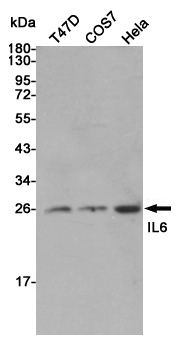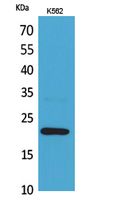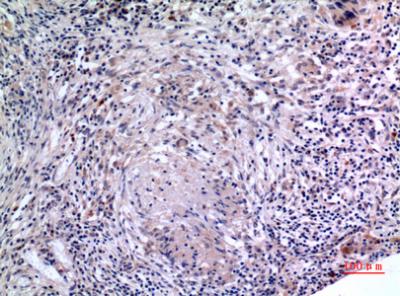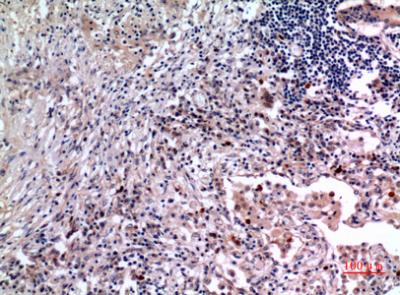



| WB | 咨询技术 | Human,Mouse,Rat |
| IF | 咨询技术 | Human,Mouse,Rat |
| IHC | 1/50-1/100 | Human,Mouse,Rat |
| ICC | 技术咨询 | Human,Mouse,Rat |
| FCM | 咨询技术 | Human,Mouse,Rat |
| Elisa | 1/10000 | Human,Mouse,Rat |
| Aliases | IL6; IFNB2; Interleukin-6; IL-6; B-cell stimulatory factor 2; BSF-2; CTL differentiation factor; CDF; Hybridoma growth factor; Interferon beta-2; IFN-beta-2 |
| Entrez GeneID | 3569 |
| WB Predicted band size | Calculated MW: 24 kDa; Observed MW: 24 kDa |
| Host/Isotype | Rabbit IgG |
| Antibody Type | Primary antibody |
| Storage | Store at 4°C short term. Aliquot and store at -20°C long term. Avoid freeze/thaw cycles. |
| Species Reactivity | Human |
| Immunogen | The antiserum was produced against synthesized peptide derived from the Internal region of human IL6. AA range:131-180 |
| Formulation | Purified antibody in PBS with 0.05% sodium azide,0.5%BSA and 50% glycerol. |
+ +
以下是3-4条关于IL-6抗体的参考文献及简要摘要:
---
1. **文献名称**: *Interleukin-6 receptor inhibition with tocilizumab reduces disease activity in rheumatoid arthritis*
**作者**: Nishimoto, N. et al.
**摘要**: 该研究报道了抗IL-6受体抗体托珠单抗(Tocilizumab)在类风湿性关节炎(RA)中的疗效。通过随机对照试验证明,托珠单抗可显著降低炎症标志物(如CRP)和疾病活动度评分,改善患者关节症状。
---
2. **文献名称**: *Siltuximab for multicentric Castleman’s disease: a randomized, double-blind, placebo-controlled trial*
**作者**: van Rhee, F. et al.
**摘要**: 研究评估了IL-6单抗司妥昔单抗(Siltuximab)治疗多中心Castleman病(MCD)的效果。结果显示,与安慰剂组相比,司妥昔单抗显著提高患者缓解率,并延长无进展生存期,证实IL-6通路在此疾病中的关键作用。
---
3. **文献名称**: *COVID-19 and the role of IL-6 inhibition: lessons from tocilizumab and sarilumab*
**作者**: Le, R.Q. et al.
**摘要**: 综述了IL-6抗体(如托珠单抗和沙利鲁单抗)在COVID-19重症患者中的应用。研究表明,抑制IL-6可减轻“细胞因子风暴”相关的肺损伤和全身炎症反应,降低死亡率及机械通气需求。
---
4. **文献名称**: *Targeting IL-6 in cancer therapy*
**作者**: Kumari, N. et al.
**摘要**: 探讨了IL-6在肿瘤微环境中的作用及靶向治疗潜力。研究发现,IL-6抗体可通过阻断促癌信号通路(如JAK/STAT3)抑制肿瘤生长、转移,并增强化疗敏感性,尤其在乳腺癌和结直肠癌中效果显著。
---
以上文献涵盖IL-6抗体在自身免疫病、罕见病、感染及癌症中的机制和应用研究。
Interleukin-6 (IL-6) is a pleiotropic cytokine involved in immune regulation, inflammation, hematopoiesis, and tissue homeostasis. It binds to membrane-bound IL-6 receptors (IL-6R) or soluble IL-6R, activating downstream signaling via gp130. which triggers JAK/STAT, MAPK, and PI3K pathways. Dysregulated IL-6 signaling is implicated in chronic inflammation, autoimmune diseases (e.g., rheumatoid arthritis), and cancers. Elevated IL-6 levels are also associated with severe outcomes in infections, including COVID-19. due to its role in cytokine storms.
IL-6-targeted therapies, developed over the past two decades, include monoclonal antibodies (mAbs) blocking IL-6 itself (e.g., siltuximab) or IL-6R (e.g., tocilizumab, sarilumab). Tocilizumab, a humanized anti-IL-6R mAb, is approved for rheumatoid arthritis, juvenile idiopathic arthritis, and cytokine release syndrome (CRS) linked to CAR-T therapy or COVID-19. Siltuximab, targeting IL-6 directly, is used for multicentric Castleman’s disease. These antibodies suppress inflammatory responses, reduce acute-phase proteins (e.g., C-reactive protein), and alleviate symptoms.
Despite efficacy, challenges remain, including infection risks, drug resistance, and variable patient responses. Ongoing research explores IL-6 inhibition in neurodegenerative diseases, metabolic syndromes, and cancer immunotherapy. Novel strategies, such as bispecific antibodies or small-molecule inhibitors, aim to improve specificity and reduce side effects. IL-6 antibodies represent a cornerstone in biologics, highlighting the therapeutic potential of cytokine modulation in diverse pathologies.
×